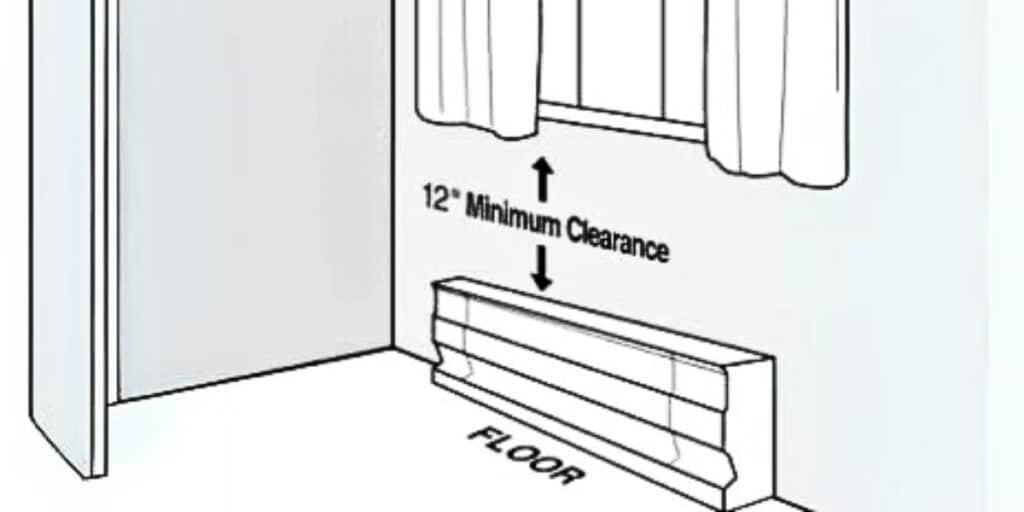If you are currently adding electric baseboard heaters to the home and want to know how to size and install them, you come to the right place. Here are some electric baseboard heater rules of thumb that will help you install it correctly.
You are permitted to wire multiple electric baseboard heaters together. However, you must pay attention to the total wattage and not overload your circuit breaker. The total wattage will also determine the wire and circuit breaker size.
Calculating Heater Wattage
To determine the total size of wattage needed for a room, multiply the length by the width of the room. Once you have that number, multiply it by 10.
WARNING: 240 volts is beyond what most DIYers can safely handle. If you plan to install 240-volt baseboard heaters, consider working with a professional to install the units and wiring.
So, let’s say you want to install electric baseboard heat in a bedroom that is 10 feet long x 12 feet wide. So, the minimum total wattage needed is 1200 [(10×12)x10=1200]. This would require a 1 – 5 foot heater (1250 watts) or 2 – 3 foot heaters (1500 watts) at 240 volts. Electric baseboard heaters rated at 240 volts are approximately 250 watts per foot.
Determining if you need 1 or 2 depends upon the number of windows in the bedroom and furniture layout. You want to place the heater under a window because the heat will rise to clash with the cold from the window, causing natural convection and circulating the heat around the room.
You are NOT permitted to install the heater under a receptacle or in any area where explosive vapors, gases, liquids, or excessive lint or dust are present. You also need 12 inches of clearance above the heater and 6 inches of clearance on each side of the heater.
To determine the wire and circuit breaker sizes, divide the total wattage by the voltage, giving you the amperage. Let’s say you install the 2- 3 foot heaters, then 1500 watts divided by 240 volts = 6.25 amps.
U.S. Electrical Code Guidance on Electrical Load vs Wire Size for Electric Heaters
According to the National Electrical Code® (NEC®) section 424.3(A), “Branch circuits supplying two or more outlets for fixed electric space-heating equipment shall be rated 15, 20, 25, or 30 amperes.” So, you will need to use a 15 amp breaker, which requires 14 AWG wires.
According to NEC®, section 424.3(B), “Fixed electric space heating equipment shall be considered a continuous load.” This means you can fill the circuit breaker to 80 percent of the total load.
So, let’s say you want to also put an adjacent bedroom on this circuit. Let’s also say this adjacent bedroom is 10 feet wide by 12 feet long. If you wired the two bedrooms’ heaters, the total connected load is 12.5 amps. You can only fill a 15 amp breaker to 80 percent of the total load or 12 amps. So, you need to increase the breaker size to 20 amps and the wire size to 12 AWG.
Electric Baseboard Heater Layout
Proper layout and installation of electric baseboard heaters are crucial for maximizing efficiency and ensuring safety. The placement of your baseboard heater can significantly affect its performance and your room’s overall comfort. This guide’ll discuss the optimal layout for electric baseboard heaters and provide a step-by-step installation process.
Optimal Location for Baseboard Heaters
The best location for an electric baseboard heater is typically under a window. This placement is strategic for a few reasons:
- Counteracting Cold Air: Windows are common sources of drafts and cold air. Placing the heater under a window helps to counteract the cold air descending from the window glass, creating a more evenly heated space.
- Clearance Requirements: Safety is paramount when installing any heating element. Ensure sufficient clearance around the heater — generally, about 12 inches from furniture and other objects. Also, maintain a distance of at least 6 inches from curtains or drapes to mitigate fire risks.
Installation Process for Electric Baseboard Heaters
Before beginning the installation, gather essential tools such as a drill, screwdriver, and wire stripper, and ensure you have a basic understanding of your home’s electrical system.

Follow these steps for a safe installation:
- Power Shutdown: Safety first – turn off the power at the circuit breaker to prevent any electrical hazards.
- Mounting the Heater: Follow the manufacturer’s instructions for mounting the heater to the wall. This typically involves securing the heater at a predetermined height and ensuring it is level.
- Wiring Connection: Connect the heater’s wiring to your home’s electrical system. This step usually involves connecting the heater’s wires to the power supply wires. It’s crucial to ensure that these connections are secure and properly insulated.
- Securing and Testing: Once the heater is connected and mounted, keep it in place per the manufacturer’s guidelines. Then, restore power to test the heater. Check for proper operation and ensure there are no electrical issues.
How to install a programmable thermostat for electric baseboard heat?
As for the thermostat, I recommend a wall-mounted thermostat over a unit-mounted t-stat. If your budget allows, I also recommend a programmable thermostat.
Using the wall-mounted t-stat will heat the room evenly. Using a programmable thermostat will allow you to turn your settings up and down automatically.
So, you can turn the heat down to 62 degrees during the day while you are at work and set it to automatically adjust to 68 degrees just before you arrive home. This is also recommended to do while you are sleeping at night. This will save you money on your electric bill.
To wire the room, simply install a cable from the breaker box to the thermostat and the thermostat to the heater(s). The cable from the breaker box will connect to the line side of the t-stat, and the cable to the heater will connect to the load side of the t-stat. All-electric baseboard heaters come with instructions on how to wire them.
Installing an electric baseboard heater involves careful planning, from choosing the right location to following a structured installation process.
By placing the heater strategically under a window and ensuring adequate clearance, you can enhance the efficiency and safety of the heating system. Always prioritize safety by turning off the power during installation and carefully following the manufacturer’s instructions.
With these guidelines, you can successfully install your electric baseboard heater and enjoy a more comfortable, warm space in your home. Remember, it’s always best to consult with or hire a professional electrician if you’re unsure about the electrical aspects.

